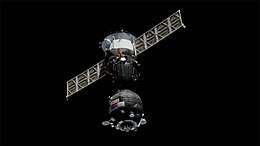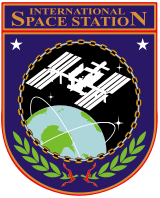Soyuz MS-16
Soyuz MS-16 is a Soyuz spaceflight launched on 9 April 2020,[3] which transported three members of the Expedition 62/63 crew to the International Space Station.[5]
 Irkut approaches the ISS | |
| Mission type | Crewed mission to ISS |
|---|---|
| Operator | Roscosmos |
| COSPAR ID | 2020-023A |
| SATCAT no. | 45465 |
| Mission duration | 76d 7h 34m (in progress) |
| Spacecraft properties | |
| Spacecraft | Soyuz-MS No. 745 Irkut[1][2] |
| Manufacturer | RKK Energia |
| Launch mass | 7,280 kilograms (16,050 lb) |
| Crew | |
| Members | |
| Start of mission | |
| Launch date | 9 April 2020, 08:05:06 UTC[3] |
| Rocket | Soyuz-2.1a (B15000-042)[1] |
| Launch site | Baikonur Site 31/6 |
| Contractor | Progress Rocket Space Centre |
| End of mission | |
| Landing date | TBA 2020 (planned) |
| Orbital parameters | |
| Reference system | Geocentric |
| Regime | Low Earth |
| Altitude | 419-440 km[4] |
| Inclination | 51.64°[4] |
| Docking with ISS | |
| Docking port | Poisk zenith |
| Docking date | 9 April 2020, 14:13:18 UTC[4] |
| Time docked | 76d 1h 26m |
 .jpg) Chris Cassidy, Anatoli Ivanishin and Ivan Vagner | |
This flight was the first crewed launch using the Soyuz 2.1a rocket, and the first crewed Russian mission not to launch from Gagarin's Start — the pad at Baikonur Cosmodrome that was before its planned modernisation for Soyuz-2 rockets after Soyuz MS-15 — since Soyuz MS-02 in 2016.[6]
Crew
| Position | Crew member | |
|---|---|---|
| Commander | Expedition 62 Third spaceflight | |
| Flight Engineer 1 | Expedition 62 First spaceflight | |
| Flight Engineer 2 | Expedition 62 Third spaceflight | |
Backup crew
| Position | Crew member[4] | |
|---|---|---|
| Commander | ||
| Flight Engineer 1 | ||
| Flight Engineer 2 | ||
Crew notes
This flight would have marked the first spaceflight for rookie cosmonaut Nikolai Tikhonov, who has been removed from several ISS flights due to delays to the Russian Nauka Laboratory module starting with Soyuz MS-04. Tikhonov and Babkin were replaced by their backups, Ivanishin and Vagner, for medical reasons.[7] Tikhonov, the original Soyuz commander, suffered an eye injury, and Russian officials opted to swap both Russian crew members with the back-up crew.[8]
Tikhonov and Babkin were expected to fly on Soyuz MS-17, scheduled for October when Tikhonov's eye injury was set to have had healed, although the two have been kept back until at least Soyuz MS-18, currently targeting launch for March 2021, in order for them to be aboard the station for the arrival of the aforementioned Nauka laboratory module, currently set for launch around May 2021[9].
Due to the COVID-19 pandemic, the crew's families and media representatives could not watch the launch in Baikonur, and the usual pre-launch traditions dating back to Yuri Gagarin's flight on Vostok 1 were cancelled.[8]
Mission
Soyuz MS-16 was launched on 9 April 2020 at 08:05:06 UTC. The Soyuz 2.1a booster's first and core stage engines ignited on time and lifted the rocket away from its firing stand at the Baikonur Cosmodrome, with cosmonaut Anatoli Ivanishin, joined by the rookie Ivan Vagner on the left and astronaut Chris Cassidy on the right. Like Ivanishin, Cassidy is making his third space flight. NASA Administrator Jim Bridenstine tweeted congratulations: "Chris Cassidy, Anatoly Ivanishin and Ivan Vagner are safely in orbit, No virus is stronger than the human desire to explore. I'm grateful to the entire @NASA and @roscosmos teams for their dedication to making this launch a success".
The International Space Station passed directly over the launch site about three minutes before the launch and the booster climbed directly into the plane of its orbit. Six orbits after that, at 14:13:18 UTC, the Soyuz docked at the Poisk docking compartment.[10]
References
| Wikimedia Commons has media related to Soyuz MS-16. |
- Navin, Joseph (4 March 2020). "Preparations continue amid crew shuffle for Soyuz MS-16". NASASpaceFlight.com. Archived from the original on 20 June 2020. Retrieved 20 June 2020.
The Soyuz 2.1a built specifically for the Soyuz MS-16 mission is B15000-042 (V15000-042) [...] The serial number for the specific Soyuz spacecraft that is going to be flown on MS-16 is No. 745.
- Gebhardt, Chris (8 April 2020). "Russia conducts first Soyuz 2.1a human launch; MS-16 crew arrives at Station". NASASpaceFlight.com. Archived from the original on 20 June 2020. Retrieved 20 June 2020.
Soyuz will use the call sign "Irkut" for this mission, after the river Commander Ivanishin’s home city is named after.
- "Утвержден экипаж космического корабля "Союз МС-16"" [The crew of MS-16 Soyuz spacecraft has been approved] (in Russian). Interfax. 27 June 2019. Retrieved 28 August 2019.
- "Soyuz MS-16". spacefacts.de. 20 February 2020. Retrieved 20 February 2020.
- "ISS: Expedition 62". spacefacts.de. 20 February 2020. Retrieved 20 February 2020.
- "Soyuz MS-02". spacefacts.de. 20 April 2018. Retrieved 14 January 2020.
- Clark, Stephen (19 February 2020). "Russian space agency replaces cosmonauts on next space station crew". Spaceflight Now. Retrieved 20 February 2020.
- "Astronaut's family won't attend launch next month due to coronavirus threat". 20 March 2020. Archived from the original on 22 March 2020. Retrieved 22 March 2020.
- https://twitter.com/katlinegrey/status/1262358285249847296
- https://spaceflightnow.com/2020/04/09/soyuz-crew-docks-with-the-international-space-station/ - 10 April 2020

